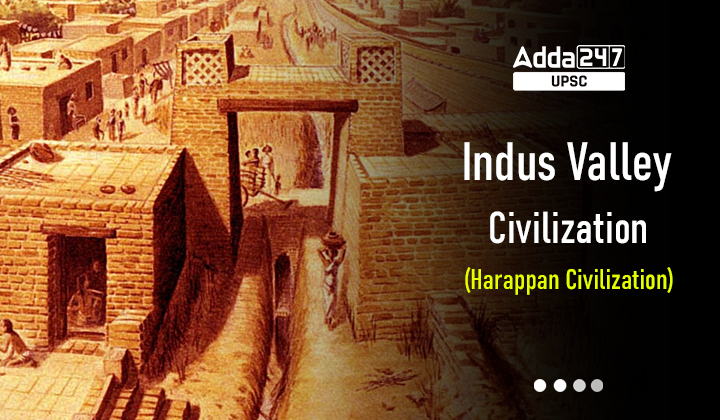Table of Contents
Indus Valley Civilization: Indus civilization, also called Indus Valley civilization or Harappan civilization is the earliest known urban culture of the Indian subcontinent. Harappan Civilization is important for the UPSC Prelims Exam (Ancient Indian History) and UPSC Mains Exam (GS Paper 1- Indian History- Indian culture will cover the salient aspects of Art Forms, Literature, and Architecture from ancient to modern times.
Background of Indus Valley Civilization
The Indus Valley Civilization, one of the earliest urban cultures, thrived around 2500–1900 BCE. It was notable for its advanced city planning, writing system, and trade practices.
- The beginning of the Indus Valley Civilization (IVC) also marks the beginning of Indian history.
- The Indus Valley Civilisation (Harappan Civilization) is believed to have existed through its early years of 3300-1300 BCE.
- The Mature period of Indus Civilization is from 2600 to 1900 BCE.
- As early as the 1850s, Britishers who were constructing railway line in the cities of Lahore and Karachi discovered many fire-baked bricks lodged in the dry terrain.
- The workers used some of them to construct the roadbed, unaware that they were using ancient artifacts.
- They soon found among the bricks stone artifacts made of soapstone, featuring intricate artistic markings.
- Initially, many archaeologists believed that they had discovered traces of the ancient Maurya Empire.
- Mauryan Empire was a large empire that dominated ancient India between c. 322 and 185 BCE.
Who Discovered Indus Valley Civilization (Harappan Civilization)?
The Harappan Civilization, also known as the Indus Valley Civilization, was discovered by Marshall, Rai Bahadur Daya Ram Sahni, and Madho Sarup Vats. The initial findings were made in 1921 at Harappa in the Punjab region, followed by discoveries in 1922 at Mohenjo-Daro, near the Indus River in the Sindh region.
Evolution of Indus Valley Civilization
The evolution of the Indus Valley Civilization (Harappan Civilization) can be divided into four phases-Pre-Harappan, early-Harappan, mature-Harappan, and late Harappan.
- Pre-Harappan: (7000 BCE – 5500 BCE): It overlaps with a Neolithic period which is best exemplified by sites like Mehrgarh.
- It shows evidence of agricultural development, domestication of plants and animals, and production of tools and ceramics.
- Mehrgarh was a farming village.
- Early-Harappan (5500 BCE-2600 BCE): This period saw the sign of development of trade and commerce, especially with other civilizations like Egypt, Mesopotamia, and possibly China.
- Ports, docks, and warehouses were built near waterways by communities living in small villages which further promoted trade and commerce.
- Mature-Harappan (2600 BCE – 1900 BCE): Mature-Harappan period of the Indus Valley Civilization saw the construction of great cities and widespread urbanization.
- Harappa and Mohenjo-Daro along with many other cities were flourishing during this period.
- Well-structured drainage, granaries, and other sophisticated infrastructure development are features of this period.
- Late Harappan (1900 BCE – 1500 BCE): This period saw the decline of the Indus Valley Civilisation which coincided with a wave of migration of the Aryan people from the north, most likely the Iranian Plateau.
- There are other evidence also which suggests climate change caused flooding, drought, and famine.
- This period also saw declining in trade relations with Egypt and Mesopotamia which has also been suggested as a contributing cause towards the decline of the Harappan civilization.
The Indus civilization, also known as the Indus Valley civilization or Harappan civilization, was the Indian subcontinent’s first known urban culture and one of the world’s three early civilizations (the others being Mesopotamia and Egypt). Sophisticated settlements and the development of trade and society are the key features of the Harappan Civilization.
| Related Articles | |
| The Palaeolithic Age | The Neolithic Age |
| The Chalcolithic Culture | Economic and Social life of Aryans |
| The Mesolithic Age | Advent of Aryans |



 TSPSC Group 1 Question Paper 2024, Downl...
TSPSC Group 1 Question Paper 2024, Downl...
 TSPSC Group 1 Answer key 2024 Out, Downl...
TSPSC Group 1 Answer key 2024 Out, Downl...
 UPSC Prelims 2024 Question Paper, Downlo...
UPSC Prelims 2024 Question Paper, Downlo...





